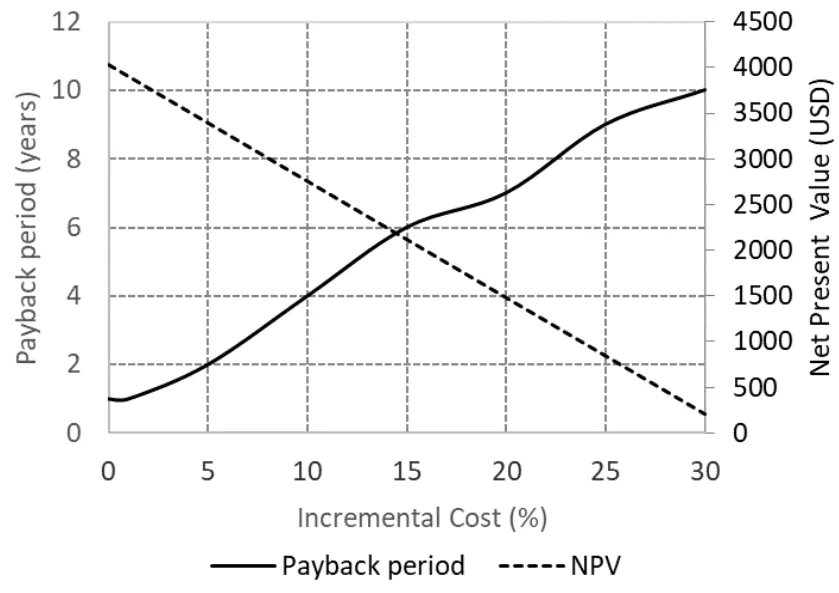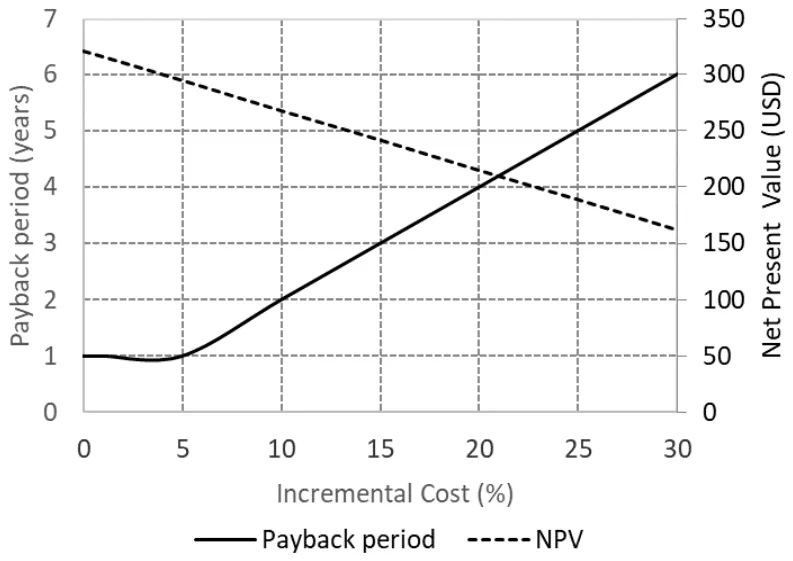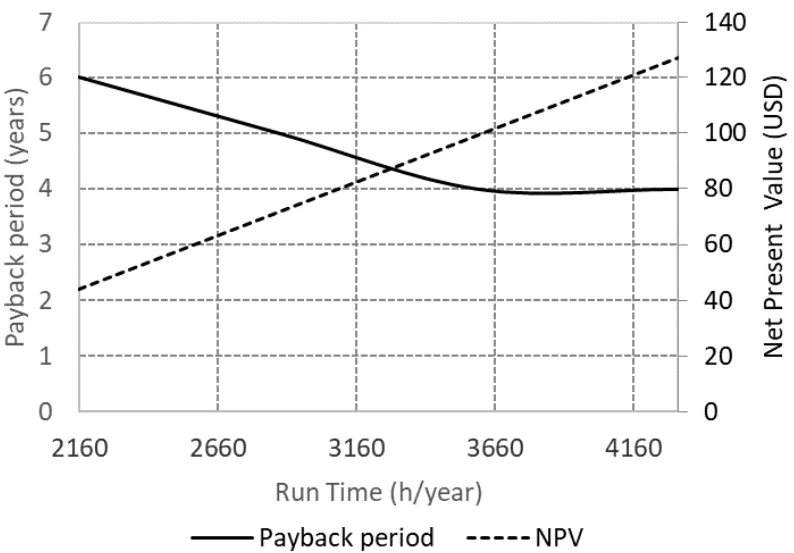この紹介論文の内容は、[出版社:International Journal of Electrical and Computer Engineering (IJECE)]によって発行された[論文タイトル:Induction motors with copper rotor: a new opportunity for increasing motor efficiency]という論文に基づいています。

1. 概要:
- タイトル:銅ロータ誘導電動機:モータ効率向上のための新たな機会
- 著者:Percy R. Viego Felipe, Vladimir Sousa Santos, Julio R. Gómez Sarduy, José P. Monteagudo Yanes, Enrique Ciro Quispe
- 出版年:2023年
- 出版ジャーナル/学会:International Journal of Electrical and Computer Engineering (IJECE)
- キーワード:銅ロータ誘導電動機、経済的実現可能性、電気モータ、エネルギー効率、高効率モータ
2. 抄録:
銅ロータ誘導電動機(CURIM)は、アルミニウムロータ(ALRIM)よりもロータ融解損失が少ないため、最近導入されました。さらに、CURIMを使用すると、IE4およびIE5の効率レベルに到達しやすくなります。CURIMは、小型モータ、エスカレーター、および電気自動車アプリケーションに有利です。ただし、CURIMは、スリップ、力率、温度上昇、およびトルク低下の問題を示すため、分析する必要があります。本研究では、割引手法を適用して、CURIMとALRIMを使用する経済的実現可能性を比較しました。循環運転のある砂糖会社で事例研究を実施し、そこで5.5 kWのモータが製粉機のフィーダーの中間導体に設置されます。この施設は、3〜6か月間、3シフトで稼働します。ALRIMに対するCURIMのコスト増加(ACI)は、1.1〜1.5倍でした。年間3,600時間および4,000時間の運転で、ACIが10%を超えると、投資回収期間が4年以上になり、正味現在価値(NPV)が直線的に増加することがわかりました。
3. 導入:
アルミニウムロータ誘導電動機(ALRIM)の代わりに銅ロータ誘導電動機(CURIM)を使用すると、ロータ損失を大幅に削減できます。これは主に、銅の電気伝導率がアルミニウムの約170%であるためです。したがって、機械全体の損失も減少します。中電力誘導電動機では、総損失の15%〜25%から、効率が2%〜5%増加します[1]、[2]。ただし、アルミニウムと比較して銅の融点が高い(銅の場合は1,083°C、アルミニウムの場合は660°C)ため、銅の鋳造プロセスに関する問題を最初に解決する必要がありました。現れた根本的な困難は、ダイの寿命の短縮、純粋な銅の鋳造プロセスでの酸化、および溶融銅に分散した多孔性でした[2]。
電力コストが増加するにつれて、モータのライフサイクルコストが不可欠であるという認識が高まり、消費者はより効率的なモータに対してより高い初期コストを支払うことの利便性を認識しました[3]。さらに、政府の規制とインセンティブが推進要因となっています。そのため、多くの企業や団体が銅鋳造の欠点を解消するために取り組み、ロータ製造用のダイ材料と鋳造プロセスを開発し、大量生産を可能にし、経済的にしました[1]、[2]、[4]。
4. 研究の概要:
研究テーマの背景:
銅ロータ誘導電動機(CURIM)は、アルミニウムロータ(ALRIM)よりもロータ融解損失が少ないため、最近導入されました。さらに、CURIMを使用すると、IE4およびIE5の効率レベルに到達しやすくなります。CURIMは、小型モータ、エスカレーター、および電気自動車アプリケーションに有利です。
既存の研究の状況:
アルミニウムと比較して銅の融点が高い(銅の場合は1,083°C、アルミニウムの場合は660°C)ため、銅の鋳造プロセスに関する問題を最初に解決する必要がありました。現れた根本的な困難は、ダイの寿命の短縮、純粋な銅の鋳造プロセスでの酸化、および溶融銅に分散した多孔性でした[2]。
研究の目的:
本論文では、構造特性と関連コスト、運転、損失、電気機械、エネルギー、および温度特性に基づいて、CURIMとALRIMを比較します。最後に、CURIMを同容量のALRIMに置き換えた結果を比較することにより、砂糖工場で5.5 kWモータを置き換える経済的実現可能性調査を実施します。
コアスタディ:
CURIMでの銅鋳造プロセスに関する調査は、メーカーが製造した特定のタイプ(つまり、定格電力、極数、電圧)の銅ロータモータを設計、鋳造、および設置するコストが、別のメーカーのコストと異なる可能性があることを示しています。
5. 研究方法論:
研究デザイン:
循環運転のある砂糖会社で事例研究を実施し、そこで5.5 kWのモータが製粉機のフィーダーの中間導体に設置されます。この施設は、3〜6か月間、3シフトで稼働します。
データ収集と分析方法:
経済分析は、差分正味現在価値(Differential NPV)[27]の基準を使用して事例研究で実施されたため、同じまたはほぼ同じコスト(たとえば、固定子コスト、設置コスト、メンテナンスコスト)が排除されます。
研究テーマと範囲:
同容量のALRIMでCURIMを置き換えた結果を比較することにより、砂糖工場で5.5 kWモータを置き換える経済的実現可能性調査を実施します。
6. 主な結果:
主な結果:
- 表1. 11.2 kW CURIM 7台の平均損失分離 [5]
- 表2. 11.2 kWモータのその他の性能特性 [5]
- 表3. 11.2 kWモータの測定トルク値 [5]
- 表4. ALRIMと比較したさまざまなCURIMの効率向上と総損失削減 [5]
- 表5. AlとCuの小型ロータ75 kWモータの比較 [2]
- 表6. 11 kW、6極エスカレーター銅ロータモータのパラメータ [2]
- 表7. 160 kW電気自動車のパラメータ [2]
- 表8. 5.5 kWモータの差分NPV法を使用した経済分析パラメータ [27]



図のタイトルリスト:
- 図1. 4,000時間の運転に対する初期増分コストとしてのNPVと投資回収期間関数
- 図2. 初期差分コストと8,000時間の運転の関数としてのNPVと投資回収期間
- 図3. 初期増分コストと可変運転時間の関数としてのNPVと投資回収期間
7. 結論:
本研究では、エネルギー効率を高めるための誘導電動機の新しい技術的改善の1つとして、CURIMの利点と欠点を評価しました。その結果、ロータ、摩擦、およびビーティングの銅損失と追加損失がALRIMよりもCURIMで低く、したがって効率が高いことを示すことができました。
8. 参考文献:
- [1] D. Liang, J. Yu, X. Yang, and V. Zhou, "Copper rotor motors in China," in 2013 International Conference on Electrical Machines and Systems (ICEMS), Oct. 2013, pp. 2031-2034, doi: 10.1109/ICEMS.2013.6713191.
- [2] D. Liang, L. Gao, and V. Zhou, "Recent trend development for high performance copper rotor motors in China," in 2018 21st International Conference on Electrical Machines and Systems (ICEMS), Oct. 2018, pp. 2571-2575, doi: 10.23919/ICEMS.2018.8549253.
- [3] S. Lie and C. Di Pietro, "Copper die-cast rotor efficiency improvement and economic consideration," IEEE Transactions on Energy Conversion, vol. 10, no. 3, pp. 419-424, 1995, doi: 10.1109/60.464863.
- [4] D. Liang, X. Yang, J. Yu, and V. Zhou, "Experience in China on the die-casting of copper rotors for induction motors," in 2012 XXth International Conference on Electrical Machines, Sep. 2012, pp. 256-260, doi: 10.1109/ICElMach.2012.6349874.
- [5] D. T. Peters, J. G. Cowie, E. F. Brush, and D. J. Van Son, "Copper in the squirrel cage for improved motor performance," in IEEE International Electric Machines and Drives Conference 2003, IEMDC'03, vol. 2, 2002, pp. 1265-1271, doi: 10.1109/IEMDC.2003.1210402.
- [6] S. Yamamoto, "Overview of the latest research and development for copper die-cast squirrel-cage rotors," in 2018 International Power Electronics Conference (IPEC-Niigata 2018 -ECCE Asia), May 2018, pp. 1949-1954, doi: 10.23919/IPEC.2018.8507971.
- [7] D. Liang and V. Zhou, "Recent market and technical trends in copper rotors for high-efficiency induction motors," in 2018 International Power Electronics Conference (IPEC-Niigata 2018 -ECCE Asia), May 2018, pp. 1943-1948, doi: 10.23919/IPEC.2018.8507879.
- [8] M. Thieman, R. Kamm, and J. Jorstad, "Copper motor rotors: Energy saving efficiency, now also economic feasibility," in 2007 Electrical Insulation Conference and Electrical Manufacturing Expo, Oct. 2007, pp. 328-333, doi: 10.1109/EEIC.2007.4562637.
- [9] R. Yabiku, R. Fialho, L. Teran, A. Santos, E. Rangel, and D. Dutra, "A comparative study between copper and aluminum induction squirrel cage constructions," in 2010 Record of Conference Papers Industry Applications Society 57th Annual Petroleum and Chemical Industry Conference (PCIC), Sep. 2010, pp. 1-9, doi: 10.1109/PCIC.2010.5666832.
- [10] ANSI, "Motors and generators," NEMA, 2016, Accessed Feb. 02, 2022. [Online]. Available: https://www.nema.org/docs/default-source/standards-document-library/ansi_nema-mg-1-2016-contents-and-foreword.pdf?sfvrsn=f27547b8_1
- [11] D. T. Peters, E. F. Brush, and J. L. Kirtley, "Die-cast copper rotors as strategy for improving induction motor efficiency," in 2007 Electrical Insulation Conference and Electrical Manufacturing Expo, Oct. 2007, pp. 322-327, doi: 10.1109/EEIC.2007.4562636.
- [12] Q. Zhang, H. Liu, Z. Zhang, and T. Song, "A cast copper rotor induction motor for small commercial EV traction: Electromagnetic design, analysis, and experimental tests," CES Transactions on Electrical Machines and Systems, vol. 2, no. 4, pp. 417-424, Dec. 2018, doi: 10.30941/CESTEMS.2018.00053.
- [13] M. Popescu, N. Riviere, G. Volpe, M. Villani, G. Fabri, and L. di Leonardo, "A copper rotor induction motor solution for electrical vehicles traction system," in 2019 IEEE Energy Conversion Congress and Exposition (ECCE), Sep. 2019, pp. 3924-3930, doi: 10.1109/ECCE.2019.8912248.
- [14] V. Mallard, G. Parent, C. Demian, J.-F. Brudny, and A. Delamotte, "Increasing the energy efficiency of induction machines by the use of grain-oriented magnetic materials and die casting copper squirrel cage in the rotor," IEEE Transactions on Industry Applications, vol. 55, no. 2, pp. 1280-1289, Mar. 2019, doi: 10.1109/TIA.2018.2873532.
- [15] A. Marfoli, M. Di Nardo, M. Degano, C. Gerada, and W. Chen, "Rotor design optimization of squirrel cage induction motor-part I: problem statement," IEEE Transactions on Energy Conversion, vol. 36, no. 2, pp. 1271-1279, Jun. 2021, doi: 10.1109/TEC.2020.3019934.
- [16] M. Di Nardo, A. Marfoli, M. Degano, C. Gerada, and W. Chen, "Rotor design optimization of squirrel cage induction motor-part II: results discussion," IEEE Transactions on Energy Conversion, vol. 36, no. 2, pp. 1280-1288, Jun. 2021, doi: 10.1109/TEC.2020.3020263.
- [17] D. Fodorean, C.-V. Pop, and D.-C. Popa, "Electromagnetic and structural analysis of an induction motor with copper rotor bars used in automotive applications," in 2021 IEEE 6th International Forum on Research and Technology for Society and Industry (RTSI), Sep. 2021, pp. 340-345, doi: 10.1109/RTSI50628.2021.9597235.
- [18] A. T. De Almeida, F. J. T. E. Ferreira, and A. Q. Duarte, "Technical and economical considerations on super high-efficiency three-phase motors," IEEE Transactions on Industry Applications, vol. 50, no. 2, pp. 1274-1285, Mar. 2014, doi: 10.1109/TIA.2013.2272548.
- [19] P. R. Viego, J. R. Gómez, and E. A. Padrón, "New syncronous high-efficiency motors," Universidad y Sociedad, vol. 12, no. 2, pp. 205-211, 2020. Accessed Jan. 21, 2022. [Online]. Available: http://scielo.sld.cu/scielo.php?script=sci_arttext&pid=S2218-36202020000200205&lng=es&tlng=es
- [20] P. R. Viego-Felipe, J. R. Gómez-Sarduy, V. Sousa-Santos, and E. C. Quispe-Oqueña, "Permanent magnet assisted synchronous reluctance motors: A new advance in electric motors development," (in Spanish), Ingeniería, investigación y tecnología, vol. 19, no. 3, pp. 269-279, Jul. 2018, doi: 10.22201/fi.25940732e.2018.19n3.023.
- [21] P. R. Viego, V. Sousa, J. R. Gómez, and E. C. Quispe, "Direct-on-line-start permanent-magnet-assisted synchronous reluctance motors with ferrite magnets for driving constant loads," International Journal of Electrical and Computer Engineering (IJECE), vol. 10, no. 1, pp. 651-659, Feb. 2020, doi: 10.11591/ijece.v10i1.pp651-659.
- [22] G. C. Mechler, "Manufacturing and cost analysis for aluminum and copper die cast induction motors for GM's powertrain and R&D Divisions," Thesis, Massachusetts Institute of Technology, 2010.
- [23] A. Marfoli, M. DiNardo, M. Degano, C. Gerada, and W. Jara, "Squirrel cage induction motor: a design-based comparison between aluminium and copper cages," IEEE Open Journal of Industry Applications, vol. 2, pp. 110-120, 2021, doi: 10.1109/OLA.2021.3073820.
- [24] H.-R. Noh, H.-S. Shin, C.-M. Kim, and K.-C. Kim, "A study on the effect of rotor bars of induction motor for electric vehicle," in 2021 24th International Conference on Electrical Machines and Systems (ICEMS), Oct. 2021, pp. 1415-1418, doi: 10.23919/ICEMS52562.2021.9634599.
- [25] Ministerio de Justicia, "System for the formation of electricity rates for the collection of electricity service: Gaceta Oficial No. 26," (in Spanish) Gaceta Oficial No. 26 (Extraordinaria), La Habana, Cuba, 2021. Accessed: Apr. 13, 2021. [Online]. Available: https://www.gacetaoficial.gob.cu/sites/default/files/goc-2021-ex26_0_0.pdf.
- [26] J. C. Andreas, Energy-efficient electric motors: selection and application. United States: Marcel Dekker, Inc., New York, NY, 1982.
- [27] M. J. Landt and A. D. Reed, "Project evaluation," in Archaeological Data Recovery in the Piceance and Wyoming Basins of Northwestern Colorado and Southwestern Wyoming, Archaeopress Publishing Ltd, 2018, pp. 333-336.
- [28] Siemens Industry, "General purpose low voltage cast iron frame motors," Siemens Industry, USA, 2011. Accessed Dec. 13, 2021. [Online]. Available: https://assets.new.siemens.com/siemens/assets/api/uuid:ff39a5d9-875a-4f16-bf17-79beae7a11c7/nema-general-purpose-motors-cast-iron-gp100-brochure.pdf
- [29] R. Saidur and T. M. I. Mahlia, "Energy, economic and environmental benefits of using high-efficiency motors to replace standard motors for the Malaysian industries," Energy Policy, vol. 38, no. 8, pp. 4617-4625, Aug. 2010, doi: 10.1016/j.enpol.2010.04.017.
- [30] B. Cassoret, J. Manata, V. Mallard, and D. Roger, "Comparative life cycle assessment of induction machines made with copper-cage or aluminium-cage rotors," IET Electric Power Applications, vol. 13, no. 6, pp. 712-719, Jun. 2019, doi: 10.1049/iet-epa.2018.5401.
9. Copyright:
- This material is a paper by "[Percy R. Viego Felipe]". Based on "[Induction motors with copper rotor: a new opportunity for increasing motor efficiency]".
- Source of the paper: [DOI: 10.11591/ijece.v13i3.pp2409-2418]
This material is summarized based on the above paper, and unauthorized use for commercial purposes is prohibited.
Copyright © 2025 CASTMAN. All rights reserved.